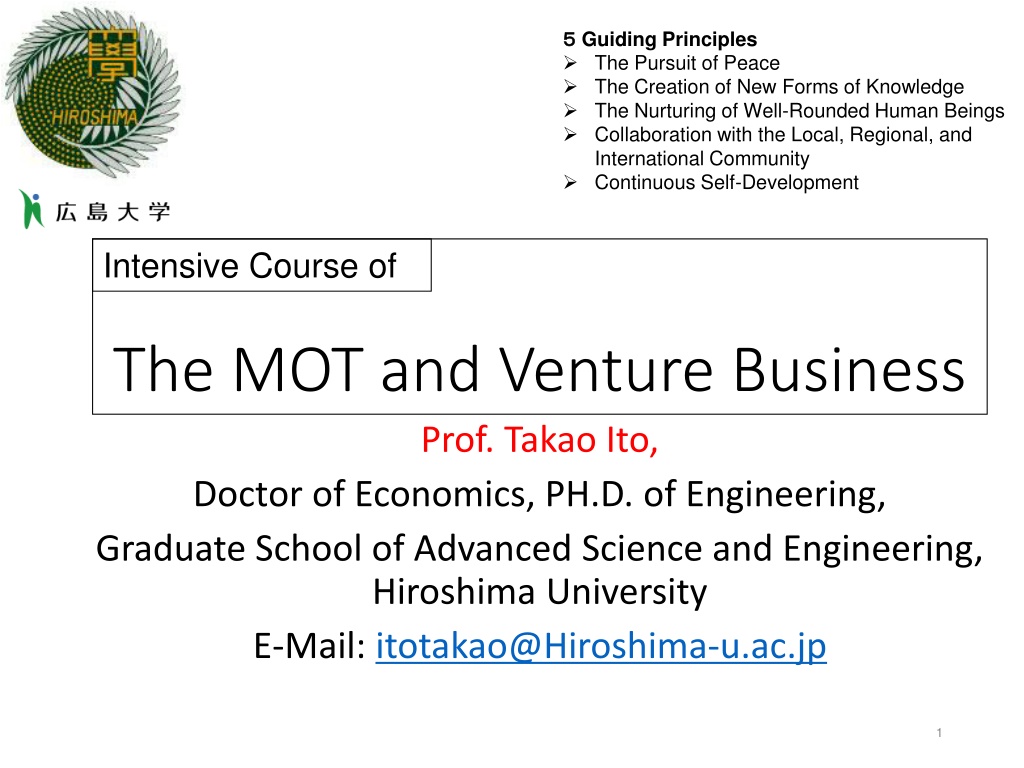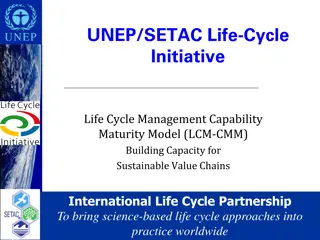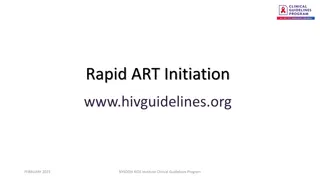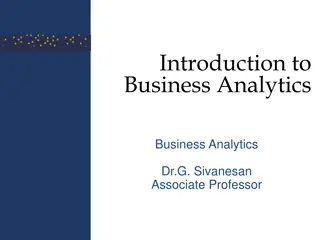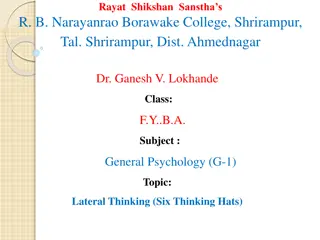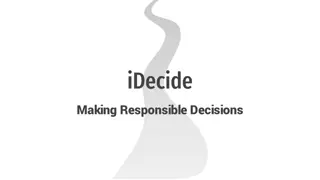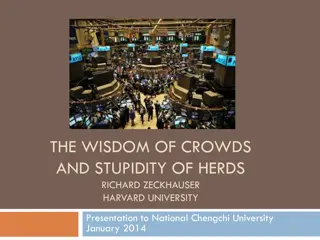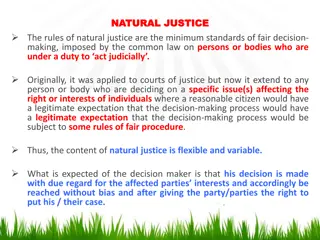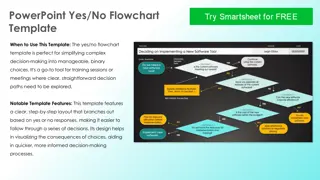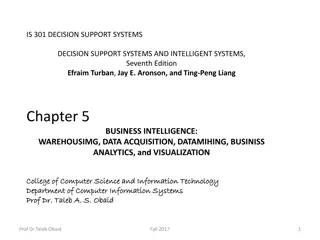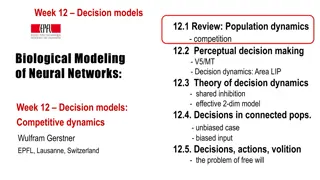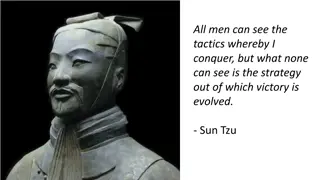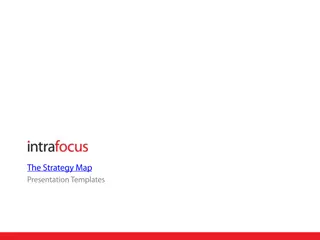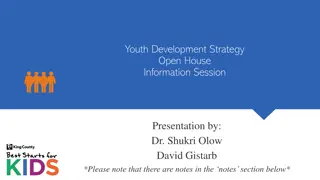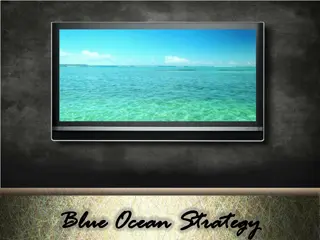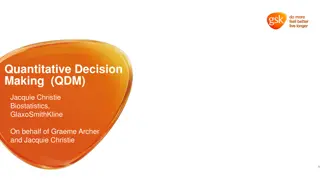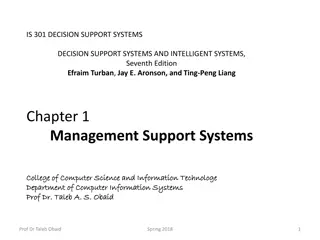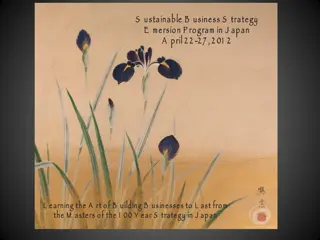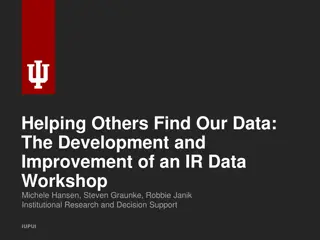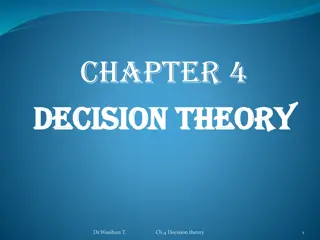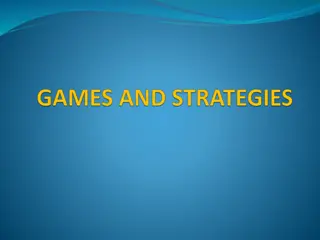The Art of Decision Making and Strategy in Business
Explore the essence of decision making, crisis management, and corporate strategy in the context of business through stages like identifying issues, generating solutions, and implementing choices. Learn from expert Prof. Takao Ito in an intensive course on MOT and Venture Business. Dive deep into evaluating alternatives, making informed decisions, and understanding the premises of effective decision making in a competitive environment.
Download Presentation

Please find below an Image/Link to download the presentation.
The content on the website is provided AS IS for your information and personal use only. It may not be sold, licensed, or shared on other websites without obtaining consent from the author. Download presentation by click this link. If you encounter any issues during the download, it is possible that the publisher has removed the file from their server.
E N D
Presentation Transcript
Guiding Principles The Pursuit of Peace The Creation of New Forms of Knowledge The Nurturing of Well-Rounded Human Beings Collaboration with the Local, Regional, and International Community Continuous Self-Development Intensive Course of The MOT and Venture Business Prof. Takao Ito, Doctor of Economics, PH.D. of Engineering, Graduate School of Advanced Science and Engineering, Hiroshima University E-Mail: itotakao@Hiroshima-u.ac.jp 1
Schedule MOT and Venture Business (An Intensive Course) 08:50-16:20, Saturday and Sunday No. Date 1 2023/10/21Sat Outlines and Introduction 2 2023/10/21Sat The evolution of Management 3 2023/10/21Sat Key Issues in Corporate Management 4 2023/10/21Sat Break-Even Point Analysis 5 2023/10/22Sun Cost Benefit Analysis and Ethics 6 2023/10/22Sun Stock Control 7 2023/10/22Sun Case Studies and Group Discussion 8 2023/10/22Sun Kaizen and Quality Control 9 2023/11/11Sat Motivation (self Learning) 10 2023/11/11Sat Organization Structure 11 2023/11/11Sat Decision-making and Strategy 12 2023/11/11Sat Leadership 13 2023/11/12Sun Business Plan 14 2023/11/12Sun Entrepreneur and Venture Business 15 2023/11/12Sun Presentation and/or Final Examination 16 2023/11/12Sun Review and Free Discussion Lecture 08:50-10:20 10:30-12:00 13:10-14:40 14:50-16:20 08:50-10:20 10:30-12:00 13:10-14:40 14:50-16:20 08:50-10:20 10:30-12:00 13:10-14:40 14:50-16:20 08:50-10:20 10:30-12:00 13:10-14:40 14:50-16:20 2
Topic 11 Decision-making and Strategy
Agenda 1. Decision Making 2. Decision Making in a Crisis 3. Strategy and Corporate Strategy 4
1. Decision Making The thought process of selecting a logical choice from the available options through information gathering, Alternative calculation, and decision.
Identifying and diagnosing the program The stages of decision making Generating alternative solutions Evaluating alternatives Making the choice Implementing the decision Evaluating the decision
Premises of your decision making Value premise: It will be very difficult to say your decision is correct or not because of impossible calculation. Factual premise: It is easy to say that your decision is better or worse because the results of your decision will be determined scientifically.
Two kinds of decision making Programmed decisions Decisions encountered and made before, having objectively correct answers, and solvable by using simple rules, policies, or numerical computations. Non-programmed decisions New, novel, complex decisions having no problem answers.
Difference between programmed and non- programmed decision Programmed Decisions Non-programmed Decisions Frequent, repetitive, routine. Much certainty regarding cause-and-effect relationships Novel, unstructured. Much uncertainty regarding cause-and -effect relationships. Problem Necessity for creativity, intuition, tolerance for ambiguity, creative problem solving. Dependence on policies, rules, and definite procedures. Procedure Business firm Periodic reorders of inventory.Diversification into new products and markets. Necessary grade-point average for good academic standing. Health careProcedure for admitting patients. GovernmentMerit system for promotion of state employees. Construction of new class-room facilities. Purchase of experimental equipment. Reorganization of state government agencies. University Examples
Organizational decision making Models of organizational decision processes Decision makers cannot be truly rational because 1) they have imperfect, incomplete information about alternatives and consequences; 2) the problems they face are so complex; 3) human beings simply cannot process all the information to which they are exposed; 4) there is not enough time to process all relevant information fully; and 5) people, including managers within the same firm, have conflicting goals.
Organizational decision making Constraints on decision makers You cannot do whatever you want because of various constraints you face: financial, legal, market, human, and organizational that inhibit certain actions.
Some useful concepts in decision making Bounded rationality: A less-than-perfect form of rationality in which decision makers cannot be perfectly rational because decisions are complex and complete information is unavailable. Incremental model: Model of organizational decision making in which major solutions arise through a series of smaller decisions.
Decision making in groups Potential advantages Potential disadvantages Larger pool of information One person dominants. More perspectives and approaches Satisficing. Intellectual stimulation Groupthink. People understand the decision People are committed to the decision Goal displacement.
Managing group decision making Leadership Constructive conflict 1. Air legitimate differences; 2. Stay task-related; 3. Be impersonal; 4. Play devil s advocate. 1. Avoid domination; 2. Encourage input; 3. Avoid groupthink and satisficing; 4. Remember goals. Effective group decision making Creativity 1. Brainstorm; 2. Avoid criticizing; 3. Exhaust ideas; 4. Combine ideas.
2. Decision Making in a Crisis You must make decisions under a great deal of pressure in crisis situations. Your organization should prepare for crises in advance. You should be able to answer the following questions: 1) What kinds of crises could your company face? 2) Can your company detect a crisis in its early stages? 3) How will it manage a crisis if one occurs? 4) How can it benefit from a crisis after it has passed?
Common but mistaken beliefs: how not to handle crisis management We don t have a crisis. We can handle a crisis. Crisis management is a luxury we can t afford. If a major crisis happens, someone else will rescue us. Accidents are just a cost of doing business. Most crises are the fault of bad individuals; therefore, there s not much we can do to prevent them. Only executives need to be aware of our crisis plans; why scare our employees or members of the community? We are tough enough to react to a crisis in an objective and rational manner.
Examples of Decision making Product Line A Payroll costs=USD15,000/Month, Depreciation cost and other fixed costs=USD500/Month, Unit variable costs=USD100; Product Line B Payroll costs=USD22,000/Month, Depreciation cost and other fixed costs=USD800/Month, Unit variable costs=USD50; What is your decision? Production Line A 50000 45000 Production Line B 40000 35000 30000 25000 20000 15000 10000 5000 0 0 50 100 150 200 250 300 17
Demand We choose B if the demand is 300 pcs. If the demand will be changed depends on probabilities as below. Better 400 0.3 Same as before 300 0.5 Worse 100 0.2 Better 400 0.2 Same as before 300 0.2 Worse 100 0.4 18
Demand We choose B if the demand is 300 pcs. If the demand will be changed depends on probabilities as below. Better 400 0.3 120 Same as before 300 0.5 150 Worse 100 0.2 20 290 Better 400 0.2 80 Same as before 300 0.2 60 Worse 100 0.4 40 180 19
3. Strategy and Corporate Strategy The art and science of planning and marshalling resources for their most efficient and effective use. The overall scope and direction of a corporation and the way in which its various business operations work together to achieve particular goals.
The strategic Management Process Establishment of mission, vision, and goals Strategy formulation Strategy implementation Strategic control
Analysis of internal strengths and weaknesses Establishment of mission, vision, and goals SWOT analysis and strategy formulation Strategy implementation Strategy control Analysis of external opportunities and threats
Tools of strategy formulation and strategy formation The BCG matrix The GE-McKinsey matrix SWOT analysis Porter s basic strategies Competitive advantage 23
The BCG matrix On the horizontal axis: relative market share - this serves as a measure of SBU strength in the market On the vertical axis: market growth rate - this provides a measure of market attractiveness
Star Strategies Leader expanding industry Generates large profits Requires substantial investments to sustain growth Farthest down on experience curve relative to competition Increase sales e.g. new markets, new channels of distribution Increase market share
Problem Child or ? Low market share in expanding industry Needs substantial cash to improve its position Slow progress on experience curve Increase sales (limit to niche or increase market share (limit to niche) Leave market
Cash Cow Leader in mature or declining industry Can generate funds for other SBUs Maintain market share e.g. ensure quality, build customer loyalty, develop substitute brands Maximize Cash Flow e.g. increase usage rate, rate of replacement, modify expense structure, raise prices
Dogs Low market share in a mature or declining industry Slow progress on experience curve Cost disadvantages and few growth opportunities Harvest or Divest Concentrate on niches requiring limited effort
Strategy Implications BCG Star Leader in Expanding Industry BUILD - Continue to increase market share if necessary at expense of short-term earnings Problem Child Low market share in Expanding Industry HARVEST if weak, BUILD if strong. Assess chances of dominating segment. If good, go after share. If bad, redefine business or withdraw.
Strategy Implications BCG Cash Cow Leader in mature or declining industry HOLD - Maintain share and cost leadership until further investment becomes marginal Maximize cash flow Dogs Low market share in a mature or declining industry DIVEST Plan an orderly withdrawal so as to maximize cash flow or concentrate on niches that require limited effort
Assumptions of Growth /Share Matrix High market share generates cash revenues ? High Market growth uses more cash resources ?
Issues with Growth/Share Matrix Market growth is not the only factor related to cash usage. Market growth is not necessarily related to cash usage. Market share is not necessarily related cash generation. Multiple factors lead to profitability. Cash is not the only factor in evaluating a portfolio.
Issues With Growth/Share Matrix Limited to industries where experience curve is relevant Appropriate for volume industries Overlooks perils of growth Measurement problems Product-market definition problems Difficult to implement strategies
SWOT Analysis matrix Internal analysis External analysis Strengths Opportunities Weaknesses Threats 35
Strategies The business portfolio is the collection of businesses and products that make up the company. The best business portfolio is one that fits the company's strengths and helps exploit the most attractive opportunities.
Basic Competitive strategy Competitive advantages Low cost Differentiation Strategy target Cost Leadership Differentiation Focus Cost focus Differentiation Focus 37
The five forces affecting industry competition Potential New Entrants Threat of new entrants Bargaining power of of buyers Bargaining power suppliers The firm s rivalry vs. industry competitors Suppliers Buyers Threat of substitute products Substitute products from other industries 38
Thank you for your attention! Thank you for your attention!
